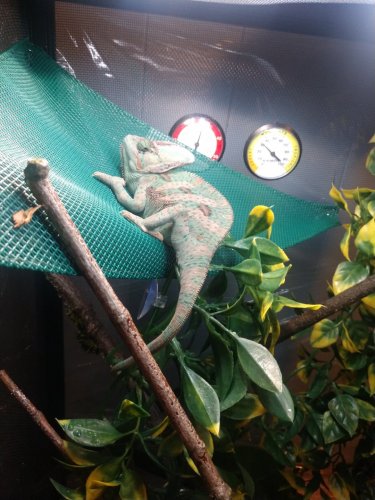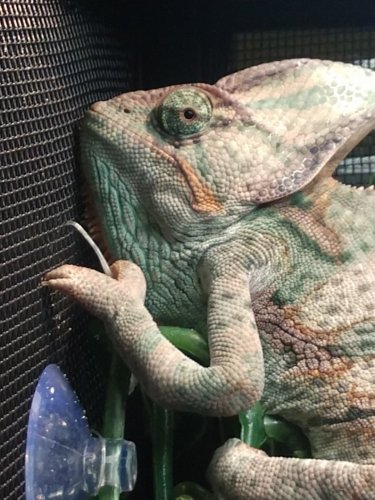Chameleon Info:
Cage Info:
- Your Chameleon - Veiled Chameleon, male, about 5-6 months old (The pet store owner claimed), been in my care for about 2 1/2 weeks
- Handling - Only handled him twice so far, once to put him in the terrarium, and once when inspecting him for this post. Otherwise, I've been working on hand feeding him (Which he's been somewhat reluctant about). He's not super aggressive and only hisses when I get too close (Without offering him water, then he doesn't hiss but actually willingly drinks and has actually grabbed one of my figures once). He usually only hisses once or twice before he stops and just stares at me.
- Feeding - Mostly crickets so far, ~5/day. Been gut-loading crickets with a bunch of oranges I had before I got him, was planning on throwing in some other vitamin D fruits.
- Supplements - I've been using Repti calcium with d3 (as was recommended by the pet store employee who said she had some chameleons of her own) since we got him, dusting every other day. As for vitamins, I haven't fed him any since I was told gut loading would be enough
- Watering - I mist for 1-2 minutes every 5ish hours, with a dripping system. I've only ever seen him drink when I offer him water in a little, flattish plastic cup, and a few times when I wet my hand and put it next to him.
- Fecal Description - Generally wet and brown, one was more dry and black recently. Never tested for parasites.
- History - Not much known history. He's been pretty active the first two weeks I got him, then the past day or two he's been moving slower, not so much standing on branches but dragging himself on them.
Cage Info:
- Cage Type - 18x18x36 inches, mesh on all sides (Plastic wrap on two to help keep moisture in)
- Lighting - "Zoo Med Tropical UVB & Heat Lighting Kit " with 5.0 UVB and heating light that came with it (60 watts). At first, I kept the UVB on for about 14 hours and the heat lamp on all the time as per pet store owner's advice, but I found online that wasn't ideal and started turning them off at the same time. I'm planning on getting either a 10.0 or 5.0 UVB hood just incase this is from a lack of UVB.
- Temperature - Ambient is 65F at night and 75F during the day, with basking spot reaching 80-85F. I use a generic thermometer
- Humidity - 40%-55% generally. I have a humidifier next to the terrarium that I have on almost constantly. I use a generic hydrometer bought with the thermometer.
- Plants - All plastic, with plans to get a live plant soon.
- Placement - On the floor of the bedroom, low traffic in a closed off room. The top of the cage is 36 inches off the ground since it's located on the ground, I know it should be higher off the ground and I've been meaning to get a table from one of my neighbors to put it one that they offered me.
- Location - Seattle, Washington. Suburbs.








